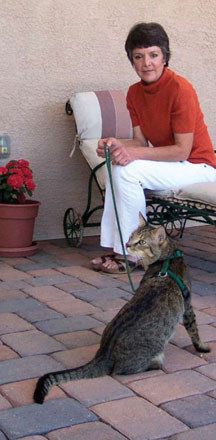Lucky, a striking gray tabby with white paws and bright green eyes, touches blades of grass, rolls around on the sunny deck and strolls over to sniff thorny blackberry branches. Its all part of his regular walk around the fenced backyard with his human companion, who supervises his short outings. Since he is not particularly agile, his owner doesnt worry about quick escapes or even a leash. Buckys feline buddy, however, is a different matter. Jade, a slender, agile black cat, loves the great outdoors as much as Bucky, but her athletic prowess easily has her up, up, and away in a matter of seconds. Walking Jade outside requires an appropriate harness and leash. 288 Whether you live with a Jade or a Bucky type, walking your cat will bear little resemblance to a conventional walk with the dog. Your cat probably will not like striding along at a brisk pace on a concrete sidewalk. That doesnt mean, however, that taking a walk with your cat isnt a great idea. “Going outdoors in a safe, supervised manner is excellent enrichment for cats that enjoy it,” says Elise Christensen, DVM, a resident at the Animal Behavior Clinic at Cornell Universitys College of Veterinary Medicine. “Each cats situation will determine whether allowing it outdoor time is the best option or not.” Leave Destination Up to Kitty Not surprisingly, your cat will determine the nature of your walks together. Some cats explore the environment by walking slowly and sniffing. Older kittens will make mad dashes for anything that moves, especially that butterfly. Others prefer to settle themselves comfortably outside and quietly watch the world pass by. Take Dr. Christensens cat, Merlin, a seven-year-old, “excessively fuzzy,” silver domestic longhair discovered at a shelter several years ago. She trained him to accept a leash and harness soon after his adoption. “He wasnt hard to train,” she says. “We went on experience the world walks, not get to a prescribed destination walks.” In his youth, Merlins walks varied in length, depending on the circumstances. “As he aged, he no longer seemed to enjoy leash walks, so now the harness is used for supervised trips out onto my porch to sit in the sun,” Dr. Christensen says. To help your cat experience the world, stretch those feline muscles and share time with you, consider the following expert tips: Choose a quiet area with few dogs and less traffic.
nitely be safer.)
Use the right equipment.
A variety of sturdy, adjustable harnesses are available for cats, including figure-eight, H-style, and walking-jacket designs. One style of feline walking jacket features an L-shaped section made of sport nylon that curls under the stomach for comfort and support; three nonbinding, adjustable straps buckle on the same side for easy fitting.Choose a style that fits your cat well and try it out in your home
– your cat should be comfortable and secure before you open the door. (A correct fit: Your finger should barely fit between your cat and the harness.) Attach your cats harness to a lightweight leash or a lead with a secure clip.Do not attach a leash to your cats collar
. Cats easily slip out of collars, especially when pulling against a leash restraint, and using one during a walk will place pressure on a cats neck. Ditto for retractable leashes – this type of leash requires pulling pressure to move, which cats dont enjoy, and can leave your cat too far afield – not a good idea in a world where bicyclists, cars and dogs can suddenly appear.Consider safety first.
Any cat that steps outside should be tested for feline immunodeficiency virus and feline leukemia virus and be up-to-date on recommended vaccinations and heartworm preventative. During walks, be aware of your surroundings and on the alert for things that might startle or frighten your cat. Ensure that your cat is identifiable (ID tag, microchip and/or tattoo) in the unlikely but possible event that you are separated. In addition, never leave your cat unsupervised during even the briefest outings; for instance, cats should not play on balconies or decks alone.Other Options

288
No matter how pleasant or enticing you try to make it, however, some cats wont enjoy walks and should not be forced to go, Dr. Christensen emphasizes. “Remember, rewards are in the eye of the receiver. A walk through a haunted house might thrill some and terrify others,” she says.
If, despite your best efforts, your cat clearly communicates “
NO” to outdoor adventures in the form of hissing, tail thrashing, growling or hiding, other options exist: For example, try giving your cat scheduled attention, training time and play sessions, and rotate her interactive toys, Dr. Christensen suggests.In the end, how you walk your cat is not the point. Whether you supervise a backyard outing or explore the neighborhood together, the key is to spend quality time with your cat.
v


